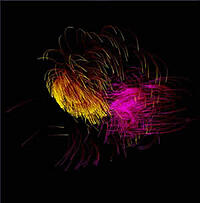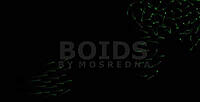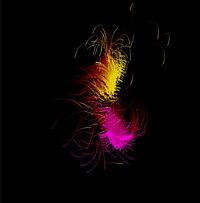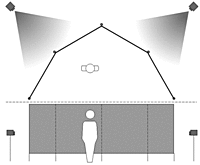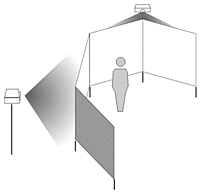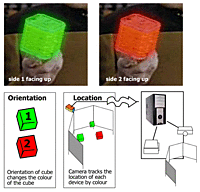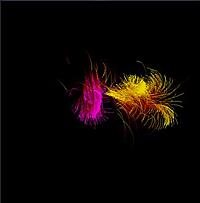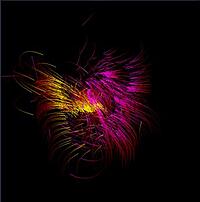Steven Harrap
Fireworks
1. Introduction
"Fireworks"; is a playful system that visually describes the motions of fireworks through a two dimensional space as projected onto screens. The fireworks are small points of light grouped by their colour. The fireworks work as groups to interact with each other. Groups of fireworks are attracted or repelled based on a simple rules system and user effect via simple tangible interfaces.
2. Our Solution
Tthis solution as an emergent system based on simple rules that produce a continually changing and engaging user experience. The system uses a simple orientation based device and the physical location of the user to effect the behaviour of the fireworks. The system is based around the concepts of Emergent systems, Computational media, Game-of-life systems and tangible media.
3. Research
"The idea of Homo Ludens - humans defined as playful creatures (Huizinga, J., 1950) - is an antidote to assumptions that technology should provide clear, efficient solutions to practical problems. From this perspective, we are characterized not just by our thinking or achievements, but by our playfulness: our curiosity, our love of diversion, our explorations, inventions and wonder."; Designing For Homo Ludens,Bill Gaver.
Our solution challenges the assumption that a clear and obvious interface is necessary for a successful user experience. We provide an antidote, as Huizinga states, by creating an exploration of interface for the user that results in a physical and virtual response by the system. Playfulness of the device and its tangibility provide a diversion that results in a visually challenging and attractive result.
Designing for Homo Ludens means allowing room for people to appropriate technologies. Playing involves pursuing one's inner narratives in safe situations, through perceptual projection or, ideally, action. If computational devices channel people's activities and perceptions too closely, then people have to live out somebody else's story, not their own (c.f. Wejchert, 2001 via Gaver ).
Through this project we will provide an opportunity for people to explore the work without the restrictions of predefined tasks, goals or narrative; in this way they are more able to own the experience rather than feeling that they are reliving someone else's predefined experience.
The project is designed as a large space with multiple controls so that it can be experienced by multiple people, In this way the work can become a collaborative experience between multiple users rather than just an individual experience in the environment.
4. Gauging our Solution
During initial stages of the projec\t the team outlined several criteria to evaluate the success of the project. The criteria are as follows.
- People able to interact with the exhibit seamlessly
- people enjoy exhibit
- exhibit engages people
- If project is able to successfully implement proposed prototype
5. Technical Design of our prototype - Physical
5.1. Visual Effects and output
Screen shots and ideas of potential visual effects.
5.2. Screen setup
"Fireworks"; uses 4 large screens each approximately 1.5 meters in length formed in a semicircular arrangement. Two projects placed at 45 degrees to the back of the screens will back project the visuals onto the screens. There would be enough room for 3 people to comfortably move around inside the system.
5.3. Controller Design and usage
The following is a potential solution for the control. For sake of description we are currently a cube as a description for the cube.
The cube has at max six inputs that it transmits to the computer. The inputs affect the behaviour of the fireworks. The input that is transmitted is determined by the face that is held upwards. The user may get immediate visual feedback the desired face is being correctly held up by glowing LEDs.
The control uses the receiver and transmitter packages from a standard remote control car. The transmitter can clearly describe at least six outputs and the receiver can easily receive the inputs and pass them onto an Arduino for delivery to the computer.
6. Technical design of our prototype - Virtual
6.1. Requirement analysis and evaluation of virtual system
The system, as currently designed will have the following inputs.
- The system has two cameras each which will report a maximum of 3 points, with x and y coordinates and a colour
-
through processing these points the system will be supplied with an x y and z coordinate and the appropriate colour
- point1.xyzc
- point2.xyzc
- point3.xyzc
returning a value of orientation from each of the cubes were discussed but in the end if the cube is capable of changing colour as we intend it to do so, this information is already being supplied to the system.
6.2. Elements of the System
The virtual system will feature the following elements the system will contain two swarms with the following properties
- colour
- speed
- direction/orientation
- swarm attraction
other elements of the system include
- sound
- background colour
The physical component will consist of 3 cubes, the cubes as stated above will change colour depending on their orientation.
| Colour | Action |
|---|---|
| Colour 1 | SwarmA, swarmB attracts |
| Colour 2 | SmarmA, swarmB repels |
| Colour 3 | SwarmA attracts, swarmB repels |
| Colour 4 | SwarmA repels, SwarmB attracts |
| Colour 5 | A,b speed increase |
| Colour 6 | Chaos |
6.3. Visual elements of the system.
The visual system at the moment employs a black background with two swarms comprised as line primitives. For this tangible media project the team discussed what would be needed to create a visual striking/polished presentation. The elements discussed are as follows.
- smoke/haze
- reflections
- ripples
- shape/form of particles
Goal states of the system have also been discussed by the project team. This matter has been set aside for the time being as it was deemed less important than other issues involved with the project.
7. Resources
This solution uses existing resources in a new configuration to achieve its goals. The following discusses the resources in use to achieve this goal.
2 projectors
Loaned from Audio Visual facilities
4 screens
4 Screens using semitransparent material from spot light and doweling rods to support the material.
Clear Perspex containers and components to enable reaction based on orientation.
1 computer with dual output video card and sound card
The computer takes input from the Arduino and delivers visual output to the two projects and audio output.
8. Conclusion
We believe that the Fireworks project proposed here is both feasible and suitable project for KIB311. In this document we have shown this by outlining our solution and detailing background research and similar solutions. We have also outlined success criteria for the project and detailed the initial design decisions made in regards to the technical requirements of the project. Having presented this information, we have shown why this is a good project for Tangible Media.
9. References
DESIGNING FOR HOMO LUDENS, Bill Gaver, Computer Related Design, Royal College of Art: w.gaver@rca.ac.uk
http://mosredna.deviantart.com/art/Boids-58821125
Notes on Braitenberg's Vehicles http://instruct.westvalley.edu/lafave/Vehicles_online.html
